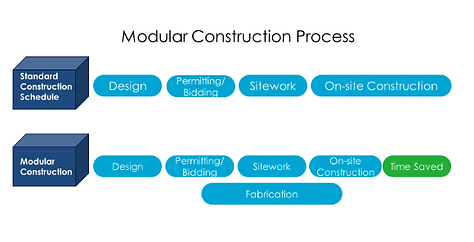Modular Construction
The major construction industry flaws focused on included, the rigid delineation of responsibility, lack of growth in productivity, demand for decreased schedule duration and more. These flaws are seen industry wide and have been plaguing the industry for the last five decades. As these issues have come to a head in the last decade construction has been forced to find new alternatives. Modular construction has been around for over a hundred years but has not been optimized. Since the dawn of the industrial age companies have working to provide factory-based construction solutions. Over the last hundred years modular construction has grown form a temporary structure and component-based industry into a permanent and volumetric structure industry. Modular construction is used to build educational, commercial, healthcare, and hospitality facilities, as well as single and multi-family housing units. As technology has advanced the industry has even made a push toward the use of modular construction in high rise facilities.


Modular construction provides a plethora of benefits to all phases of the construction process. For designers modular construction encourages early collaboration with all members of the design team and an ability for increased control of quality. From construction standpoint benefits are seen both from the factory side in decreased impacts from weather delays and increased productivity of workers, as well as, decreased on-site pollution and site disturbance. The benefits further extend to the owner in decreased schedule duration and increased predictability of cost.

After seeing all the benefits of modular construction, I began to wonder why it was not used more frequently throughout the industry. Although on a grand scale modular construction seems to be a very beneficial, it has it’s own draw backs. For designer’s modular construction is difficult to use due to the variation of building codes and standards throughout the country and size and shape restrictions which come with the need to transport the modules. From a construction perspective, contractors often faced with resistance from both owners and designers due to a lack of understanding regarding industry capability, as well as an inability to maximize the benefits of factory-based construction due to minimal repetition. Barriers for owner’s use include but are not limited to, difficulty of obtaining upfront financing and lack of information regarding industry success.



After organizing the information, we found our team went out to speak with those working in the industry. After holding interviews with designers, builders, and manufactures, our understanding of the industry was confirmed, and we were ready to provide our recommendations for how the industry should proceed. Some of our suggestion are; to aid in market growth modular construction should work to develop uniform building codes that can be accepted throughout the country, this will greatly aid in the ability of a manufacture and designer to mass produce common units. Other suggestions include a shift toward the use of integrated project delivery to help bring up possible needed design changes as early as possible.



